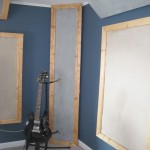 So maybe you have SONAR X1 Production Suite running on a killer computer, and now you might have a sound cloud over your mix position; what’s next? Last week I exemplified how I built and installed a hanging sound cloud and this week I will go into detail how I built corner traps to help tame my unorthodox (square) production room. Before reading this post, you may want to visit my article from last week which goes into some detail on room shapes.
So maybe you have SONAR X1 Production Suite running on a killer computer, and now you might have a sound cloud over your mix position; what’s next? Last week I exemplified how I built and installed a hanging sound cloud and this week I will go into detail how I built corner traps to help tame my unorthodox (square) production room. Before reading this post, you may want to visit my article from last week which goes into some detail on room shapes.
My room, unfortunately for me is dead square. This is about the worst case scenario so I had to do some research and talk to a lot of friends who are acoustic professionals such as Gavin Haverstick of Haverstick designs. With my room being about 13.5’ x 13.5’ and 7.5’ ceilings, he has my mix position at 62” off the front wall. So with my positioning about right, and a sound cloud overhead to take out the first ceiling reflections, the next thing to do was try to knock out the corners of the room where bass frequencies could become a big problem.
I decided to make custom corner traps based on my personal situation. Once again, every room and everyone’s needs are different, so if you are on a tight budget, I think it’s best to first figure out what’s important to YOU. For my situation, here were my goals for corner traps:
- Cost effective
- *Less square footage (I will discuss this below)
- Aesthetically pleasing to the eye
- Effective bass trapping
- Light-weight
*In my situation, my room is pretty small so I elected to make my corner traps only 1’ wide with insulation. I think if you build corner traps and have the space and money, it’s best to make the floor-to-ceiling corner traps 2’ wide. If you go the wider route, you would basically double the numbers in my example below.
 Before I go into any detail, I need to state that I am not a professional carpenter, and these are not direct instructions on “how to” build acoustic panels. I am simply showing you how I built mine, and if you care to attempt to build your own, you are responsible for how you use this information to build and install these panels on your own and AT YOUR OWN RISK. The bottom line is that neither Cakewalk nor I are in any way responsible for how you use this information. I’m not claiming in any way to be an expert on this matter. I simply did some research, talked to a lot of trusted friends, and then went for it. Also, I did use some basic power tools as well as hand tools that I will recommend, so if you are uncomfortable using tools please seek help from a professional.
Before I go into any detail, I need to state that I am not a professional carpenter, and these are not direct instructions on “how to” build acoustic panels. I am simply showing you how I built mine, and if you care to attempt to build your own, you are responsible for how you use this information to build and install these panels on your own and AT YOUR OWN RISK. The bottom line is that neither Cakewalk nor I are in any way responsible for how you use this information. I’m not claiming in any way to be an expert on this matter. I simply did some research, talked to a lot of trusted friends, and then went for it. Also, I did use some basic power tools as well as hand tools that I will recommend, so if you are uncomfortable using tools please seek help from a professional.
How I Built Corner Traps:
After analyzing my room, I decided that with my limited space I would build corner traps that have 1’ of 4” insulation from floor to ceiling. I decided to frame out the corner traps with exposed wood, and then for the wall-to-ceiling horizontal traps I would completely wrap them in the fabric. The wall-to-ceiling traps would be just 2” thick using Owens Corning 703. For the corner traps I used 4” Rockwool Insulation.
*The exact materials I used for making and installing one corner trap were (estimated costs since I used these materials for multiple panels):
– Roxul 4″ thick Mineral Wool 4′ x 2′ sheet, Cost: $13.50
– 8’ x 3” x ¾” Furring strips (wood) from Home Depot, Cost: $2.45
– Fabric – CASTIELLE ACOUSTIC SUEDE (key;-) FABRIC BY THE YARD, Cost: $5.96 (1 panel)
– Wrapping for back of panel- Home Depot paper-throw tarp, Cost: $1:39 (1 panel)
– Straight support brackets for the corners (4) Cost: $1.32
– Screws for the brackets (short screws), Cost: $.72
– 3/8ths Staples, Cost: $.25
– Polyurethane/Stain, Cost: $.82
TOTAL COST PER PANEL: $26.14 (Estimate)
Tools Used:
– Sand paper ( I used a motorized sander which was easier)
– Electric Power Miter Saw (you can very easily achieve the same cuts with a hand saw)
– Pro grade staple gun (not electric
– Staples (“T50 3/8th” 10mm Heavy Duty made by Arrow
– All-in-one polyurethane/stain and a brush
– Philips head screwdriver ( I used a power driver but a regular screwdriver would work fine)
– Knee pads
– Protective rubber work gloves, eye protection, and a breathing mask
 MEASURE AND CUT THE WOOD: The first thing I did was to cut the wood so that each edge had a 45 degree angle (the flat way.) I measured my room from floor to ceiling so I made sure that the longest points on the vertical board measured 7’ 3” from point to
MEASURE AND CUT THE WOOD: The first thing I did was to cut the wood so that each edge had a 45 degree angle (the flat way.) I measured my room from floor to ceiling so I made sure that the longest points on the vertical board measured 7’ 3” from point to point. Instead of measuring the second vertical piece, I lined it up with the first piece and drew a line so that the cut would be more accurate. I did the same for the horizontal cuts. I made the horizontal pieces 11” wide on the shortest points so that the 1’ strip of insulation would have ½’ on both sides (the long way) to be able to staple it to the wood.
point. Instead of measuring the second vertical piece, I lined it up with the first piece and drew a line so that the cut would be more accurate. I did the same for the horizontal cuts. I made the horizontal pieces 11” wide on the shortest points so that the 1’ strip of insulation would have ½’ on both sides (the long way) to be able to staple it to the wood.
 SAND THE WOOD EDGES: Next, with an electric sander (29 bucks at home depot – or use sand paper or a file) I smoothed out all the edges that I cut. I basically just made sure that there were no super sharp edges or any splintered wood sticking up. Remember, these furring strips are about $.98 each, so they are not the best quality wood and take a bit of massaging to make them look good (sanding, staining, polyurethane etc.)
SAND THE WOOD EDGES: Next, with an electric sander (29 bucks at home depot – or use sand paper or a file) I smoothed out all the edges that I cut. I basically just made sure that there were no super sharp edges or any splintered wood sticking up. Remember, these furring strips are about $.98 each, so they are not the best quality wood and take a bit of massaging to make them look good (sanding, staining, polyurethane etc.)
-
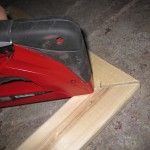 STAPLE THE BASE TOGETHER: I sought after the best looking sides of each piece and formed the structure on a flat surface upside-down. Starting in one corner I put my knees separately over each piece and line up a corner.
STAPLE THE BASE TOGETHER: I sought after the best looking sides of each piece and formed the structure on a flat surface upside-down. Starting in one corner I put my knees separately over each piece and line up a corner. I then stapled together the pieces. In my opinion, you can’t really go overboard with staples so I put quite a few in. I continued to staple the frame together on all the other corners until I had the long rectangular frame all joined together.
I then stapled together the pieces. In my opinion, you can’t really go overboard with staples so I put quite a few in. I continued to staple the frame together on all the other corners until I had the long rectangular frame all joined together.
 ADD STABILITY WITH A METAL BRACKET: I then started in another corner and again applied pressure with my knees while screwing in a bra
ADD STABILITY WITH A METAL BRACKET: I then started in another corner and again applied pressure with my knees while screwing in a bra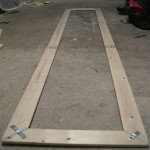 cket in each corner that went across the joining crease where the staples were. I used brackets that had two screws on each side for added stability. Once this was done the frame was complete and pretty stable and stiff.
cket in each corner that went across the joining crease where the staples were. I used brackets that had two screws on each side for added stability. Once this was done the frame was complete and pretty stable and stiff.
 STAIN/POLYURETHANE (OR PAINT): I then slapped on a hefty amount of all-in-one stain/polyurethane to the whole frame. I didn’t need to stain the back as only the front would be showing, but I did make sure all the sides on the outside and inside were covered nicely. After this was dry I actually sprayed an additional cote of just polyurethane on for added shine and protection.
STAIN/POLYURETHANE (OR PAINT): I then slapped on a hefty amount of all-in-one stain/polyurethane to the whole frame. I didn’t need to stain the back as only the front would be showing, but I did make sure all the sides on the outside and inside were covered nicely. After this was dry I actually sprayed an additional cote of just polyurethane on for added shine and protection.
 STAPLE THE FABRIC TO THE FRAME: (Through trial and error – this was the best method for making the fabric tight.) I made sure that my frame was completely dry. This is very important because the suede fabric will pick up any dampness from the wood (I found out the hard way.) I laid the frame upside-down on a flat surface again, and started in one corner stapling the fabric down the length of the frame with one staple about every 6 inches. I went to the other side (the long side) and pulling the fabric tight but
STAPLE THE FABRIC TO THE FRAME: (Through trial and error – this was the best method for making the fabric tight.) I made sure that my frame was completely dry. This is very important because the suede fabric will pick up any dampness from the wood (I found out the hard way.) I laid the frame upside-down on a flat surface again, and started in one corner stapling the fabric down the length of the frame with one staple about every 6 inches. I went to the other side (the long side) and pulling the fabric tight but 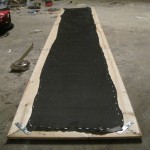 being cautious of not over stretching, I laid in staples again every six inches or so. Next, I went on one of the horizontal edges (the short piece) and while gently pulling the fabric tight I laid in staples every inch or so. Next, I went back to each long side and gently pulled the fabric tight while laying in staples between the 6” staples. Finally, I was able to get the fabric nice and tight by gently pulling it to the final remaining horizontal piece and laying in staples. Once I finished there were a few more staples to lay in to really tighten the fabric up. I then cut the fabric just outside the staples.
being cautious of not over stretching, I laid in staples again every six inches or so. Next, I went on one of the horizontal edges (the short piece) and while gently pulling the fabric tight I laid in staples every inch or so. Next, I went back to each long side and gently pulled the fabric tight while laying in staples between the 6” staples. Finally, I was able to get the fabric nice and tight by gently pulling it to the final remaining horizontal piece and laying in staples. Once I finished there were a few more staples to lay in to really tighten the fabric up. I then cut the fabric just outside the staples.
 STAPLE THE INSULATION TO THE FRAME: (USE PROTECTIVE GLOVES/EYE WEAR/MASK WHEN WORKING WITH ANY INSULATION) As I stated in my scenario, I opted to go with 1’ corner strips so that meant that I had to cut my insulation
STAPLE THE INSULATION TO THE FRAME: (USE PROTECTIVE GLOVES/EYE WEAR/MASK WHEN WORKING WITH ANY INSULATION) As I stated in my scenario, I opted to go with 1’ corner strips so that meant that I had to cut my insulation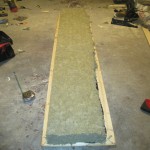 down the middle the long way as it comes in 4’ x 2’ panels. This was easy and achieved with a long kitchen knife. With the frame still upside-down and now with the fabric attached, I began to staple in the insulation to attach it to the frame. I basically first eyeballed the insulation laying over the frame so that I had roughly a ½” overlay on each side to the frame. Starting down the long way, I simply stapled the insulation to the frame (about 1 staple every 3 inches or so) right around the perimeter while gently pulling on it to make sure it was attaching properly.
down the middle the long way as it comes in 4’ x 2’ panels. This was easy and achieved with a long kitchen knife. With the frame still upside-down and now with the fabric attached, I began to staple in the insulation to attach it to the frame. I basically first eyeballed the insulation laying over the frame so that I had roughly a ½” overlay on each side to the frame. Starting down the long way, I simply stapled the insulation to the frame (about 1 staple every 3 inches or so) right around the perimeter while gently pulling on it to make sure it was attaching properly.
 WRAP AND STAPLE THE BACK OF THE PANEL WITH PAPER/POLY DROP CLOTH: As I stated before, I was going for a “cost effective” approach here with my whole room. One of the way
WRAP AND STAPLE THE BACK OF THE PANEL WITH PAPER/POLY DROP CLOTH: As I stated before, I was going for a “cost effective” approach here with my whole room. One of the way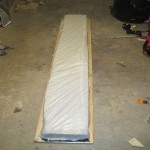 s I saved a good amount of coin was by covering the back of my panels with the above noted cloth opposed to wrapping each panel completely in the acoustic fabric. I think wrapping the insulation completely in fabric is much easier and probably a better all-around solution, but in my case I was into trying to save some dough. I achieved this by just sealing the back off with the cloth and staples. I went around the perimeter of the frame over the insulation, and then I folded the cloth back over so that it was double wrapped.
s I saved a good amount of coin was by covering the back of my panels with the above noted cloth opposed to wrapping each panel completely in the acoustic fabric. I think wrapping the insulation completely in fabric is much easier and probably a better all-around solution, but in my case I was into trying to save some dough. I achieved this by just sealing the back off with the cloth and staples. I went around the perimeter of the frame over the insulation, and then I folded the cloth back over so that it was double wrapped.
 CLEAN AND ISTALL INTO THE CORNER: In my case, I measured the length of the trap EXACTLY so that it was a few millimeters longer than the length from the floor to ceiling. Since my floor is a rug, I was able to wedge the corner piece in without having to secure it. If you are not able to use this method, I would recommend getting creative by attaching each side of the vertical boards to the walls with some sort of metal bracket. I supposed another way would be to screw them directly to the walls with 6” screws using washers on the outside of the frame and also using wall anchors if there are no wall-studs available.
CLEAN AND ISTALL INTO THE CORNER: In my case, I measured the length of the trap EXACTLY so that it was a few millimeters longer than the length from the floor to ceiling. Since my floor is a rug, I was able to wedge the corner piece in without having to secure it. If you are not able to use this method, I would recommend getting creative by attaching each side of the vertical boards to the walls with some sort of metal bracket. I supposed another way would be to screw them directly to the walls with 6” screws using washers on the outside of the frame and also using wall anchors if there are no wall-studs available.
So there you have it – pretty slick looking custom floor-to-ceiling corner traps for around 25 bucks. The real test was cranking up my SONAR Expanded rig with a fat low end Z3TA+ 2 patch. I could definitely tell the difference on how the low end responded in the room with the traps. It seems to be more in control and defined.
So after you get yourself upgraded to SONAR X1 or pick up the new SONAR X1 Production Suite which includes SONAR X1 Producer, SONAR X1 Producer Expanded, PC4K S-Type Expander / Gate ProChannel Module, and Z3TA+ 2 waveshaping synthesizer, take control of your music creation environment.
Thanks for reading and join me again here soon on the Cakewalk Blog as I exemplify how I completed this room with custom wall panels.


2 Replies to “How Building Cost Effective Acoustic Treatment for the Music Studio Will Help Your Music Production; Part 2: Corner Traps”
Comments are closed.